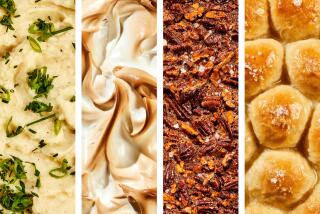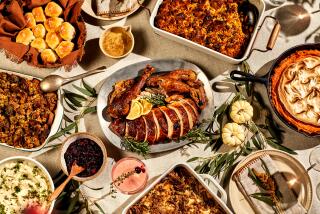Great Bird
- Share via
There’s a newcomer to this year’s Thanksgiving Handbook: the roasted brined turkey we introduced around Christmastime last year.
Brining your turkey--soaking it overnight in a salt-water solution--makes the bird more moist, more tender and more flavorful. Better yet, it requires no fancy equipment and takes only a few minutes of preparation time.
Of course, you’ll also find instructions for making a basic roast turkey as well as the bird we call “the ultimate turkey,” introduced by The Times Test Kitchen in 1992. The Test Kitchen method turns out amazingly moist meat in radically shorter time.
Here’s the basic idea: Stuffing is placed under the skin on the turkey’s breast, rather than inside the body cavity. Also, the turkey is roasted at a slightly higher than normal oven temperature--350 degrees for about nine minutes a pound instead of the usual 15 to 20 minutes per pound. Without a lump of stuffing inside the bird, the turkey can cook faster. And the stuffing on top of the breast keeps that meat moist while the dark meat cooks.
There are, however, some caveats to this method. It works best with smaller to average-size turkeys, 10- to 14-pounders. If you must have 20 pounds of bird to feed your brood, cook two smaller turkeys, rather than one large one, by this method.
To avoid embarrassing undercooked spots, realize that the turkey must be completely thawed before going in the oven. And don’t truss the bird or tuck under the wings; you need to expose the entire surface of the meat to the heat of the oven when cooking times are short.
In past years, we recommended taking the turkey out of the oven when the internal temperature of the meat reaches 155 degrees to 160 degrees (harmful bacteria are killed at 160 degrees). This took into account the “push” in temperature, usually 10 degrees or more, that comes when a turkey is taken from the oven and allowed to sit for 20 minutes while the juices set: The meat, in effect, keeps cooking after it comes out of the oven.
This year, however, providing our own margin of safety, we’re recommending the meat be 165 degrees when it’s taken from the oven. And we encourage you to test the bird in several spots with a thermometer--in the thickest part of the inner thigh and in the breast. Our tests at 165 degrees produced a bird that was quickly cooked (1 hour and 40 minutes for a 12-pound bird), though there was some sacrifice in the moistness of the breast meat.
If you decide to bring the bird out when it hits 160 degrees and find a few red spots at the joints when you begin to carve the turkey, don’t panic. Remove the leg quarters, place them in a pan and tent with foil. Return to a 350-degree oven for about 10 minutes to finish cooking while you carve the breast meat.
Turkey Express
ULTIMATE TURKEY
1 (12- to 13-pound) turkey
Salt, pepper
4 cups stuffing, about
1 stalk celery, cut into thirds
1 carrot, cut into thirds
1 small onion
Melted butter
Thaw turkey thoroughly. Even fresh turkeys normally have icy sections and must be thawed.
Rinse turkey inside and out. Pat dry. Season whole bird inside and out with salt and pepper.
Run fingers carefully between skin and flesh of turkey, loosening skin. Working slowly, push stuffing in thin layer under breast and thigh of turkey. (Excess stuffing can be baked in lightly greased casserole at 325 degrees until heated through, 45 minutes to 1 hour.) Put celery, carrot and onion into body cavity of turkey.
Put turkey in large roasting pan, breast side up. Do not truss bird and do not tuck wings under bird. Brush turkey with melted butter. Roast at 350 degrees until turkey registers 165 degrees when thermometer is placed deep into thigh, but not touching bone, about 7 to 10 minutes per pound.
Remove from oven. Let stand 20 minutes before carving; retained heat should push temperature to 175 degrees.
12 to 14 servings. Each of 12 servings contains:
416 calories; 223 mg sodium; 189 mg cholesterol; 21 grams fat; 1 gram carbohydrates; 52 grams protein; 0.13 gram fiber.
The Salt Solution
ROAST BRINED TURKEY
2/3 cup salt
1 gallon water
1 (12- to 14-pound) turkey
Combine salt and water and stir until salt dissolves to make brine. Pour brine over turkey in pot just large enough to hold both. If turkey is completely covered, don’t worry about using all of brine. Cover with foil and refrigerate 6 hours or overnight, turning 2 or 3 times to make sure turkey is totally submerged.
turkey from brine and pat dry with paper towels. Refrigerate, unwrapped, 6 hours or overnight.
Pat turkey with paper towel si it’s free of moisture, then place on its side on rack in shallow roasting pan. Roast at 450 degrees 15 minutes. Turn turkey to other sdie and roast another 15 minutes. Turn breast-side up and roast another 15 minutes. Reduce heat to 325 degrees and roast until meat thermometer inserted in center of thickest part of thigh registers 165 degrees, about 2 hours. Remove from oven and set aside 20 minutes before carving.
10 to 12 servings. Each of 12 servings:
394 calories; 792 mg sodium; 236 mg cholesterol; 12 grams fat; 1 gram carbohydrates; 65 grams protein; 0 fiber.
TRADITIONAL VALUES
ROAST TURKEY
1 (12- to 14-pound) turkey, completely thawed
Salt, pepper
Basic Bread Stuffing or stuffing of choice
Melted butter
Remove giblet bag and neck from turkey. Check both cavities for extra parts. Rinse turkey inside and out with cold water and pat dry. Sprinkle turkey inside and out with salt and pepper.
Loosely pack stuffing into neck and body cavities. Do not overstuff. Stuffing expands during cooking. Allow 1/2 to 3/4 cup stuffing per pound of turkey. Skewer neck skin to back of bird to hold stuffing in place. Truss drumsticks with clamp or skin band, or tie with kitchen twine, and tuck wings under bird.
Place turkey, breast side up, on rack in shallow roasting pan. Brush with melted butter. Roast uncovered at 325 degrees, basting with melted butter every 30 to 45 minutes. If bird is browning too fast, tent loosely with foil or cover breast with butter-soaked cheesecloth. Roast until instant-read thermometer inserted in thickest part of thigh reaches 170 degrees.
When turkey is done, remove from oven and let turkey rest at room temperature 20 minutes; retained heat should push temperature to 180 degrees.
10 to 12 servings. Each of 10 servings, without stuffing:
553 calories; 706 mg sodium; 217 mg cholesterol; 31 grams fat; 10 grams carbohydrates; 55 grams protein; 0.20 gram fiber.
Note: To roast turkey unstuffed, season bird with salt and pepper to taste inside and out. If desired, insert pieces of celery, carrots and onions to improve flavor. Fold neck skin to back and fasten with skewer. Fasten legs by tying or tucking under clamp or skin band.
BASIC BREAD STUFFING
1/2 cup butter
1 large onion, diced
1 to 2 cups diced celery with leaves
12 cups toasted 1/2-inch bread cubes
1 1/2 teaspoons salt
1/4 teaspoon black pepper
1 tablespoon dried sage or 1/4 cup minced fresh sage
1/2 cup chopped parsley
1 cup turkey stock, water or milk
Melt butter in large stockpot. Add onion and celery and cook until vegetables are tender but not browned. Add to bread cubes in large bowl. Add salt, pepper, sage and parsley and toss until well mixed. Add turkey stock and blend well.
Bake any excess stuffing in lightly greased casserole at 325 degrees until heated through, about 45 minutes to 1 hour.
Enough to stuff a 12- to 14-pound turkey, about 10 to 12 servings. Each of 12 servings:
126 calories; 469 mg sodium; 23 mg cholesterol; 9 grams fat; 10 grams carbohydrates; 2 grams protein; 0.20 gram fiber.
The Relish
You can follow the basic recipe on the back of the cranberry bag, but with just a little extra effort, you can have something really special. This recipe, from the family of Times Staff Writer Russ Parsons, has become a Thanksgiving standard in The Times Test Kitchen. It’s extremely simple. Just be sure you leave enough time before serving for the flavors to mellow, about three days. And be sure not to overcook the cranberries--that little pop when you bite is part of the pleasure.
MOM PARSONS’ CRANBERRIES
1 1/2 cups sugar
3/4 cup water
3 whole cloves
3 whole allspice
2 (3-inch) cinnamon sticks
1 (12-ounce) bag fresh cranberries
Grated zest of 1 orange
Bring sugar, water, cloves, allspice and cinnamon sticks to boil in 4-quart saucepan. Cook, stirring, until syrup is clear, about 3 minutes. Add cranberries and cook just until they begin to pop, about 5 minutes.
Remove from heat, add grated orange zest and cool. Refrigerate at least 3 days before using.
Makes 2 1/2 cups relish. Each 1/4-cup serving:
132 calories; 1 mg sodium; 0 cholesterol; 0 fat; 35 grams
carbohydrates; 0 protein; 0.41 gram fiber.
CARVING
Even expert carvers need a properly cooked turkey to do their best; overcooked turkey meat crumbles when it’s sliced. And remember to let the bird stand at room temperature 20 minutes after removing it from the oven so the juices set and the meat firms.
Use a chef’s knife to remove the legs and thighs, then switch to a very sharp carving knife for slicing the breast meat--the sharper the blade, the more attractive the slices. A serrated knife should not be used because it tends to tear the meat.
To remove the drumstick and thigh, press the leg away from the body. The joint connecting the leg to the backbone will often snap free, but if it doesn’t, it may be severed with the point of a knife.
Cut the thigh from the body by following the contour carefully with the knife. Place on a separate plate, then cut through the connecting joint between the drumstick and the thigh.
Tilt the drumstick to a convenient angle and slice the meat away in a downward motion toward the plate. Hold the thigh firmly on the plate with the fork and cut it into even slices parallel to the bone.
Wings are typically left in place to keep the bird stable while the breast meat is carved in downward slices, across the grain. Begin each slice slightly higher up on the breast, keeping the slices thin and even.
Inexperienced carvers may find it easier to tackle the bird in the kitchen rather than at the dining table. The sliced meat may then be arranged on a platter for serving.


